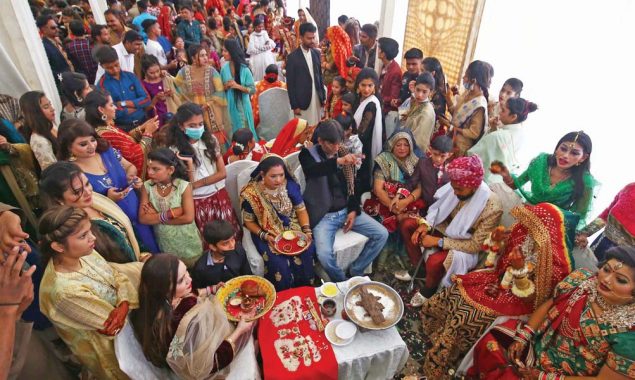Synopsis
72 couples of the Hindu community tie the knot at a collective wedding held in Karachi

Photos: Asim Rehmani/Bol News
KARACHI: On the evening of January 9, as many as 72 couples of the Hindu community tied the knot at a ceremony held near the Railway Ground in Karachi under the auspices of the Pakistan Hindu Council (PHC) which is a representative body of the nine million Hindus residing in the country.
Apart from the public proclamation of the holy union, the colourful event was marked by the exchange of gifts, wearing of special garments and feasting. The relatives and friends of the couples also participated in the mass event.
The PHC patron-in-chief Dr Ramesh Kumar Vankwani said “We had three reasons in mind for conducting the mass event. The first was financial considerations. Preference for a collective event brought certain members of the community at ease and no one had to worry about the heavy costs that come with fancy, Pakistani weddings. The second reason was our sense of community. We respect each other in the community from the bottom of our hearts and demonstrate that by such cultural events no one feels they have been left behind. The third reason was the coronavirus that has made social gatherings indeed an uphill task”.
For people who are still new to such concepts, it is important to understand that a mass wedding ceremony is a public service, he added.

PHC chief coordinator Krishan Sagar while speaking to Bol News said the event is more than just a typical mass wedding. “It is a cultural activity of our Hindu community that makes up nine million of the country’s population. These weddings are typically a three-day event. On the first day, Ganesh Puja is usually reserved for only close family members and friends. The second day is the mehndi and the sangeet events, while the actual wedding ceremony takes place on the third day. Traditionally, the couple tie the knot under the mandap, a pillared structure which is temporarily erected and heavily decorated for the main ceremonial activities”.
The wedding altar is built on the day of the wedding and the groom is welcomed by his in-laws there before the arrival of the bride. “Near the mandap is the sacred fire known as Agni — a symbol of a divine presence at the ceremony. It is lit by the Hindu priest performing the marriage rites. As part of the holy matrimony, the bride and groom encircle the fire in unity”, apprised Sagar.
He described the ‘steps before fire’ ritual and further said, “Each complete circuit around the fire is a phera performed by the Hindu couple. The first phera is a prayer for food and nourishment. The second phera is for strength. The third phera is for the prosperity of the couple. The fourth one is for the family. The fifth phera signifies progeny, the sixth is for health while the seventh and the last phera is the most special; it allows the blessed couple to embrace each other as companions with love and sacrifice so that they are able to walk together for life”.
While elaborating on the mehndi and the sangeet rituals, the PHC chief coordinator said that the mehndi is a day of joy for the bride and other female members of the Hindu family. “The participating women grace the palms, hands and feet of the bride with intricate henna designs that she continues to wear for the coming days”.
Our weddings are very well known in the visual culture as they are elaborate, he also said. “The first act is the arrival of the baraat or the jaan, as we call it. Then comes the pokwanu which is the welcoming of the groom. This is followed by Ganesh Puja and Vaar Puja. After the worship rituals is the Kanya Aagman — the arrival of the bride. This is followed by the Granthibandan and Varmala where the groom’s scarf is tied to the bride’s shawl”, he informed.
“These are some of the rituals during the Hindu wedding process. A historical tradition is the Kanyadaan. The practice symbolises the giving away of the bride’s gotra or lineage and accepting the gotra of the groom. In addition to this are the traditions of havan, mangal fera and the saptapadi — the seven steps.”
A prominent ritual is the sindur and the mangal sutra. Finally comes the akhand saubhagyavati act where married women are invited to the mandap to bless the couple and wish them luck.
“The holy ceremony is then completed by the final traditions of the aashirwad and then the vidaai”.
Preserving traditions
Sindh Assembly Member Mangla Sharma, who was present at the occasion, told Bol News that the PHC initiated the mass wedding tradition to alleviate the problems of the needy people in the Hindu community. “To ensure that our traditions are preserved and are practiced in accordance with Hindu beliefs, the council decided to hold mass events for those Hindu families who wanted to marry off their children with dignity”.

Furthermore, she said that for the Hindu community, culture and history are very important. “Many cultures and influences such as those of Buddhism, Sikhism and Jain are involved. Hinduism is a very inclusive faith, accepting and tolerant”, she added.
Ms Sharma said that among the main Rasme or rituals include anointing the couple with oil and the use of haldi in the mayun ceremony. These are considered as health practices among the Hindu community. “It purifies the body. The oil anointed on the head to relieve and protect the couple from evil. The daan is the superior ritual of all. It is the moment when the bride is finally given over to the care of the groom. On this auspicious day, the parents of the bride also fast from morning till the wedding event in the evening”.
The MPA clarified that since mass weddings tend to support people from the lower-income backgrounds, the Hindu council ensures that the needy members of the community are treated equally and with dignity. “The same cultural environment is provided to all the respected guests as is given to anybody else in the Hindu community. The wedded couple is also given assistance so they can start their new life. In the past 15 years, hundreds of such weddings have been conducted and so many couples have been blessed with our prayers. This brings positivity into their lives. The divorce rates are also significantly low since we started the practice of mass weddings.”
Rakesh Khemani, who serves as an assistant manager (education and training) for a non-profit organisation operating a network of school units in Karachi, told Bol News that as a minority group, we prefer mass weddings particularly among people from the rural backgrounds. “In the holy months, mass marriages are held to marry off most of the couples. In history, Lord Ram and his brothers were married on the same day at the same mandap. This has also influenced our modern practices”.
He added that in his hometown in Ghotki district, we welcome fellow members of the community living across the border who arrive in Pakistan for two to three weeks. “There is an event where they visit the temples and also attend mass marriages. Those who desire to marry at the large mandirs such as the one in Ghotki also request the caretakers to have a collective event to accommodate everyone”.
Moreover, Hinduism is not a monolith. “It is a Sanatani, a Sanskrit term for religious duties that incorporate various teachings from the Vedas. These are ancient notions that form the larger way of life for our community.”
The Hindu weddings are traditionally big, bright and colourful. They signify the importance of familial celebrations of love and commitment. They are also a celebration of the couple’s faith and culture. Marriages, according to the Hindu beliefs, are made in heaven and once you are married, the bond is supposed to last for seven lifetimes.
Read More News On
Catch all the Pakistan News, Breaking News Event and Latest News Updates on The BOL News
Download The BOL News App to get the Daily News Update & Follow us on Google News.




